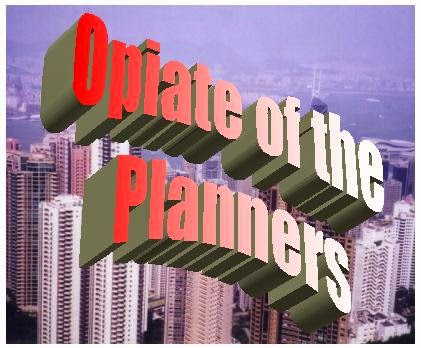 |
| image source |
Peter A. Kirby
Activist Post
“Progress will be made in the development of effective regional organization. Better coordination and cooperation between different levels of government and between public agencies and the private sector will also evolve, insuring the realization of the policy objectives contained in the 1970:1990 Regional Plan.” – From the first Bay Area Regional Plan, 1970
Recently, a little something called ‘Plan Bay Area’ has united in opposition both the political right and left. It is this way because Plan Bay Area was formulated in secrecy and is now being rammed down our throats. It is this way because Plan Bay Area annuls private property rights. It is this way because Plan Bay Area provides opportunities only for giant insider land development corporations and ‘green-collar’ workers; whatever they are. It is this way because Plan Bay Area is just a bad master development plan. It doesn’t work and it is not what we want.
The San Francisco Municipal Transportation Agency is similarly unpopular. It is this way because the San Francisco Municipal Transportation Agency is implementing the failed Plan Bay Area.
This paper outlines the ideological, rhetorical, political, administrative and financial consistencies between Plan Bay Area and the San Francisco Municipal Transportation Agency.
Plan Bay Area is a comprehensive regional redevelopment plan which coercively asserts that we should pack, rack and stack tiny housing units along transit corridors. If you’ve ever lived in a tiny apartment and/or next to a freeway, you probably understand why this plan is not popular. Plan Bay Area asserts that we should create residential areas similar to the high rise forests built under communist Russia or those described in George Orwell’s 1984.
Don’t read Plan Bay Area. It is very boring. If you would like to get up to speed as to the details of Plan Bay Area and where the issue is currently in the San Francisco region, I suggest you watch the following video:
The video was shot on May 30, 2013 at the Marin County Civic Center in San Rafael, CA and depicts a packed house of angry grassroots political activists and concerned citizens debating the crony capitalist forces of Plan Bay Area. Similar adversarial meetings producing similar results have been held all around the Bay Area. Search YouTube for ‘Plan Bay Area.’ The people have spoken and it is not in favor of Plan Bay Area.
Although Plan Bay Area’s makers assure us that they will return in a few years with a re-animated version, this edition of what they call a ‘Regional Transportation Plan’ is dead on arrival. Plan Bay Area’s Dr. Frankensteins are the Association of Bay Area Governments and the Metropolitan Transportation Commission.
The Metropolitan Transportation Commission:
The authors of the troubled Plan Bay Area are a couple of groups known as the Association of Bay Area Governments (ABAG) and the Metropolitan Transportation Commission (MTC).
 Of the two Plan Bay Area progenitors, it is the Metropolitan Transportation Commission which pertains to the San Francisco Municipal Transportation Agency; not so much ABAG. While ABAG busies itself with regional growth projections, land use issues (zoning) and many other pursuits, the MTC is exclusively concerned with transportation. The San Francisco Municipal Transportation Agency similarly deals exclusively with transportation related issues. This paper therefore focusses on the MTC. ABAG’s relationship with the MTC is the topic of another paper, but this author can assure you, they are very close.
Of the two Plan Bay Area progenitors, it is the Metropolitan Transportation Commission which pertains to the San Francisco Municipal Transportation Agency; not so much ABAG. While ABAG busies itself with regional growth projections, land use issues (zoning) and many other pursuits, the MTC is exclusively concerned with transportation. The San Francisco Municipal Transportation Agency similarly deals exclusively with transportation related issues. This paper therefore focusses on the MTC. ABAG’s relationship with the MTC is the topic of another paper, but this author can assure you, they are very close.
In 1970, CA state senator John F. Foran introduced legislation which created the MTC. The idea was to create a government body capable of coordinating the Bay Area’s many transportation systems while encouraging public transportation usage. Yes, they have an agenda.
The MTC’s first headquarters were at the Claremont Hotel in Berkeley. In 1984, construction began on the ABAG, MTC and BART shared headquarters called ‘The Metro Center’ across the street from the Lake Merritt BART station in Oakland. This is MTC headquarters today.
Today the MTC describes itself as ‘the transportation planning, coordinating, and financing agency for the nine-county San Francisco Bay Area.’ Plan Bay Area is the MTC’s master thesis.
For the purpose of this paper, the MTC is synonymous with Plan Bay Area.
The San Francisco Municipal Transportation Agency:
1999’s Proposition E created the San Francisco Municipal Transportation Agency (SFMTA/MTA) as a strong, independent agency overseeing parking, traffic and public transportation (Muni). The idea being that the SFMTA’s independence and strength would enable them to fix Muni.
The SFMTA board consists of 7 individuals appointed by the Mayor and confirmed by the Board of Supervisors.
In 2007 Proposition A folded San Francisco’s taxicab industry into the SFMTA.
Subsequently, San Franciscans paying attention have watched in horror as we have witnessed: an epic Central Subway boondoggle, a failing taxicab industry, Muni continuing their abysmal track record and among other scandals, evidence of rampant financial fraud. Power corrupts.
In 15 years, the SFMTA’s annual budget has ballooned to almost one billion dollars.
The SFMTA and the MTC:
The SFMTA and MTC are implementing the same policies. They are implementing Plan Bay Area. It is not a coincidence. The Plan Bay Area policies implemented by the SFMTA include: an emphasis on bicycling, walking, car sharing, widening of sidewalks and narrowing of streets. The MTC calls these initiatives ‘Smart Growth.’ The SFMTA calls it ‘Livable Streets’ or ‘Complete Streets.’
Both groups say all these things are necessary because we need to lower our carbon dioxide output. Because we know carbon dioxide emissions raise the Earth’s global temperature. Which we know causes nasty weather phenomena like sea level rise and therefore death, destruction, disease, global political instability and finally, nuclear and biological war and the end of Humanity. Well, at least some of us know this.
 The MTC acts as a pass-through for State and Federal funds. They administer SFMTA funding for day-to-day operations as well as for transportation expansion and improvement projects. They’ve been dumping ungodly sums into the building of the Central Subway, but that’s another story. Last year, the MTC administered 14% ($114M) of the SFMTA’s total operating budget. For 2009-2014, the MTC has administered roughly $640M. The MTC requires that all the money they give the SFMTA must go to fund programs in general compliance with Plan Bay Area.
The MTC acts as a pass-through for State and Federal funds. They administer SFMTA funding for day-to-day operations as well as for transportation expansion and improvement projects. They’ve been dumping ungodly sums into the building of the Central Subway, but that’s another story. Last year, the MTC administered 14% ($114M) of the SFMTA’s total operating budget. For 2009-2014, the MTC has administered roughly $640M. The MTC requires that all the money they give the SFMTA must go to fund programs in general compliance with Plan Bay Area.
The Complete Streets (i.e. biking, walking, traffic calming) programs are all funded by the MTC’s One Bay Area Grant program. For fiscal year 2012-13 through fiscal year 2015-16, the MTC has granted the SFMTA roughly $40 M through this program. One Bay Area is another name for Plan Bay Area.
The SFMTA’s director of transportation and CEO Ed Reiskin sits on the MTC’s powerful Bay Area Partnership group.
Current SFMTA chairman Tom Nolan was an MTC commissioner from 1987-1993.
The SFMTA is a member of something called ‘One SF.’ Their signs have been gracing construction sites all over town lately. It sounds curiously like One Bay Area or Plan Bay Area and their logos look similar. One SF is a San Francisco infrastructure planning group. The executive director of the SFMTA (the afore mentioned ‘Fast Eddy’ Reiskin) sits on their Capital Planning Committee.
Both the MTC and the SFMTA were created as consolidations of government.
The quote at the beginning of this article shows that, for a long time the makers of Plan Bay Area have been calling for the type of government consolidation seen in the SFMTA. Although a group called SPUR claims responsibility (that is a story for another article), quotes from the first Bay Area Regional Plan suggest that the MTC had something to do with it.
In ‘Regional Plan 1970-1990,’ ABAG also writes that they want to “Encourage actions by appropriate agencies that will initiate, direct and promote regional growth and development as well as conservation of the environment.” And they want to “Clarify at all levels the decision making process related to areawide problems and issues.”
One can see how these policies might inspire ABAG and the MTC to help create something like the SFMTA.
Transit First:
Many informed readers out there are saying to themselves that it is not so much that the SFMTA is implementing Plan Bay Area, but rather that the SFMTA is implementing Transit First. It is both.
Transit First is a part of the City charter which mandates encouraging the use of modes of transportation other than personal vehicles. The Board of Supervisors and the Planning Commission adopted this socially engineering portion of our Charter for us in 1973. It was never directly approved by the voters. It has subsequently been rewritten multiple times.
The SFMTA is implementing Transit First. Plan Bay Area is just rebranding coupled with an influx of investment, legislation and bureaucracy. Transit First was the concept phase. Plan Bay Area is the implementation phase.
Transit First (like ‘sustainable development;’ Plan Bay Area’s thesis) is a term that, among the uninformed, produces a positive Pavlovian response.
Sure, the forces behind Plan Bay Area endure public comment and do their ceremonial public outreach sessions, but they are obviously not taking heed. Their plans would be popular if they were. The SFMTA acts similarly. Ask a San Francisco cab driver. We’ve been pleading with them to no avail for years. But the hand that gives is above the hand that receives, so it is the MTC who is really running the show. So, let’s take a look at how the MTC and similar groups claim to be representative but are in fact not.
In 2003 at their Transportation 2030 Summit, the MTC took an electronic poll. The question was posed: “Should the goals in the 2001 Regional Transportation Plan remain basically unchanged or would you propose they be modified for the 2030 Plan?” 84% said the goals should be modified. The 2001 Regional Transportation Plan outlines the same programs as does 2013’s Plan Bay Area.
The MTC also asked, “Should the current approach to land use and transportation remain basically unchanged in the 2030 Plan or would you propose it be substantially modified?” 75% of the respondents indicated that the MTC’s approach be substantially modified. Again, the 2030 Plan, like the rest of their literature, outlines the same programs seen in Plan Bay Area.
The MTC inquired further by asking attendees if local governments, not regional agencies should continue to control local land use. 62% agreed.
The MTC asked respondents if they agreed with this statement: “Many people don’t want to live in smaller housing units in dense urban centers, so government should not try to force them.” 67% agreed. That’s a supermajority.
When asked if we should as a society “critically re-examine all of our policies, programs and projects,” 89% of summit attendees agreed. MTC chairman Steve Heminger seized upon this opportunity by saying, “It looks like the people of the Bay Area are in the mood for change.” Yes Steve, we want change. But we don’t want the change Plan Bay Area proposes. We want responsible government. That is not what you promote. We want you to change. That’s what we the people are talking about here.
Please read Bay Area activist Rosa Koire’s wonderful book Behind the Green Mask. She recounts her first hand experience with what happens to people who disagree with regional redevelopment plans like Plan Bay Area. Can you say ‘railroaded?’ Among other dirty tricks, they use something called the Delphi technique. Read Rosa’s book and find out all about it.
Although the people have spoken, the MTC has not changed course. The MTC just keeps regurgitating the same old plan over and over again. ABAG and the MTC have been pushing plans similar to Plan Bay Area since 1970. Since then, only the details have developed.
A popular definition of insanity is doing the same thing over and over again, expecting a different result. The Plan Bay Area progenitors are not crazy; they are just annoyingly persistent. They are practicing incrementalism. They don’t care what you think. They’re going to try to get their agenda through anyway, while acting like this is what you want. They assure you that either your signature or your brains will be on the contract. Plan Bay Area is backed up by California State laws like: AB 32, SB 375 and SB 743.
Plan Bay Area was crafted in secrecy. The MTC and ABAG made Plan Bay Area. The people did not. The SFMTA and the MTC are implementing an unrepresentative plan.
Conclusions:
The consistencies of policy between the SFMTA and the MTC and thus Plan Bay Area are pervasive. When one is acquainted with the situation, the pertinent question becomes not in how the SFMTA and Plan Bay Area are similar, but in how they differ. Ideologically, the SFMTA and the MTC and Plan Bay Area are identical. They only differ in their particular functions. This is typical of a uniform, top-down, corporate-style rollout.
The Marin County Civic Center meeting shows you what intelligent, educated and well spoken people think about Plan Bay Area. They think it stinks. Someone close to the situation can tell you that the SFMTA is as wildly unpopular.
 This paper proves that the MTC is implementing Plan Bay Area through the SFMTA. This unrepresentative government is forcing us to eat a big bravo sierra sandwich. These odious programs seen from both Plan Bay Area and the SFMTA are mandated by state law.
This paper proves that the MTC is implementing Plan Bay Area through the SFMTA. This unrepresentative government is forcing us to eat a big bravo sierra sandwich. These odious programs seen from both Plan Bay Area and the SFMTA are mandated by state law.
The SFMTA and the MTC do not represent the people of the Bay Area and therefore they are illegitimate. This is a problem. We need good government.
Solutions:
San Francisco should pull out of ABAG and the MTC.
State laws enforcing Plan Bay Area should be ignored or repealed.
Your author was on the steering committee and the top signature gatherer for a little something called Proposition L which failed at the ballot box this week (Nov. 4, 2014). It was a declaration of policy addressing the SFMTA’s Complete Streets programs. I guess the voters of San Francisco really want to be charged for parking meters on Sundays, holidays and after 6pm. They seem to never get enough self-flagellation. Anyway, we did our best. That’s all that matters.
http://www.restorebalance14.org/
The entire saga of the SFMTA, the San Francisco taxicab industry and this author’s exploits may be told, God willing, in a forthcoming ebook. This is not over.
Notes:
- ‘1970:1990 Regional Plan’ a report by the Metropolitan Transportation Commission, 1970
- ‘Plan Bay Area’ a report by the Association of Bay Area Governments and the Metropolitan Transportation Commission, 2013
- ‘The Birth of Bay Area Regionalism: A History of Partnership’ a video by the Association of Bay Area Governments and the Metropolitan Transportation Commission, 2011
- ‘City and County of San Francisco Voter Information Pamphlet and Sample Ballot’ by the San Francisco Department of Elections pertaining to the Nov. 2, 1999 election, 1999
- ‘Central Subway: Too Much Money for Too Little Benefit’ a report by a civil grand jury of the City and County of San Francisco, 2011
- ‘Covering Their Tracks: The Central Subway Project Buries Millions in a Deep Dark Place’ article by Joe Eskenazi, published by the SF Weekly, Apr. 2, 2014
- 2013 San Francisco Municipal Transportation Agency Annual Report
- ‘The ABCs of MTC’ a report by the Metropolitan Transportation Commission, 2007
- San Francisco Municipal Transportation Agency 2013-2014 budget
- ‘MTC One Bay Area Grant Program Funding Commitments Overview’ a report by the Metropolitan Transportation Commission
- ‘MTC One Bay Area Grant Program Project List’ an attachment (B-2) to MTC resolution no. 4035, 2012
- The Charter of the City and County of San Francisco
- ‘TransActions’ a periodical by the Metropolitan Transportation Commission, July/August 2003
- Regional Plans by the Association of Bay Area Governments: 1978 & 1980
- Regional Transportation Plans by the Metropolitan Transportation Commission: 1991, 1994, 1998, 2001, 2004 & 2009
Websites:
- onebayarea.org
- abag.ca.gov
- sfmta.com
- mtc.ca.gov
- onesanfrancisco.org
- spur.org
- sfgov.org
- democratsagainstunagenda21.com
- ca.gov
Peter A. Kirby is a San Rafael, CA author and activist. Check out his ebook Chemtrails Exposed



Be the first to comment on "The SFMTA: Implementors of the Failed “Plan Bay Area” (Local Agenda 21)"